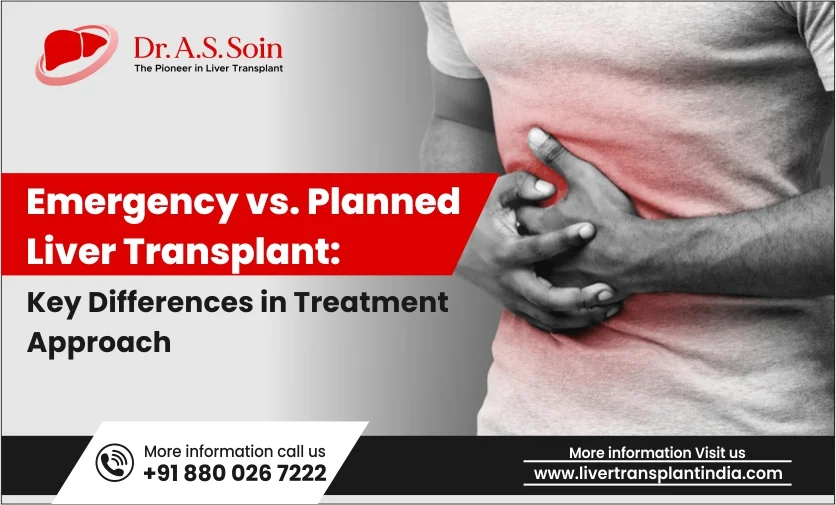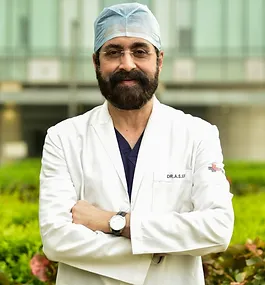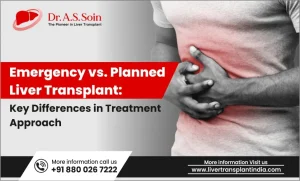Most people know that a liver transplant can save a life. What many do not realise is that not all transplants happen in the same way. Some are carefully planned after weeks of check-ups, while others are done in an emergency when a patient’s life is hanging by a thread.
The difference between a planned liver transplant and an emergency transplant is not just about time. It changes the way doctors prepare, how the surgery is carried out, the risks involved, and even the recovery later. Patients and families often feel lost when these situations come up. This article explains the two approaches in clear terms.
Table of Contents
ToggleWhy the Timing of Transplant Matters
The liver is a vital organ with multiple roles — filtering toxins, regulating metabolism, storing energy, and producing essential proteins for blood clotting. Unlike some other organs, the liver has a remarkable capacity to regenerate. But once the damage becomes severe, there comes a tipping point where the organ cannot recover on its own.
At that stage, a transplant is the only option. But the circumstances leading to that transplant are very different in:
- Planned Liver Transplant: A carefully evaluated and scheduled surgery, usually for patients with chronic liver disease.
- Emergency Liver Transplant: A high-stakes procedure performed when the patient is in acute liver failure or rapid deterioration, leaving little or no time for preparation.
Planned Liver Transplant: Stepwise, Structured, and Optimized
A planned transplant happens when doctors have the luxury of time. These patients usually suffer from chronic liver disease conditions such as:
- Cirrhosis due to hepatitis B, hepatitis C, alcohol-related liver disease, or fatty liver disease.
- Genetic or metabolic disorders.
- Early-stage hepatocellular carcinoma (liver cancer).
Since the decline is gradual, doctors monitor the patient’s health using tools like the MELD (Model for End-stage Liver Disease) score. This scoring system predicts the urgency of transplantation by assessing kidney function, clotting profile, and bilirubin levels.
Key characteristics of planned transplant include:
- Comprehensive evaluation – Patients undergo weeks of assessments: blood work, imaging, heart and lung tests, infection screening, and nutritional evaluation. This ensures that surgery is done only when the patient is strong enough to benefit.
- Donor planning – In a living donor liver transplant (LDLT), time allows matching, preparing, and optimizing the donor. In deceased donor transplants, patients can be placed on the waiting list systematically.
- Risk optimization – Patients are stabilized with medication, controlled diet, and supportive therapies to ensure they are in the best possible condition before surgery.
- Team preparedness – Surgeons, anesthesiologists, and ICU teams can schedule the procedure, plan resources, and anticipate possible complications.
In simple terms, a planned transplant is a controlled operation with a high degree of predictability.
Emergency Liver Transplant: Racing Against Time
An emergency transplant is a very different scenario. These are patients who often arrive in the hospital with sudden acute liver failure or rapid worsening of chronic liver disease. Common causes include:
- Acute viral hepatitis (like hepatitis A, B, or E).
- Drug-induced liver injury (paracetamol overdose being a classic example).
- Autoimmune hepatitis flare.
- Acute-on-chronic liver failure (when a cirrhosis patient suddenly worsens due to infection, bleeding, or toxins).
Here, time is the enemy. The patient may develop confusion, jaundice, bleeding, swelling, and even multi-organ failure within days.
Key characteristics of emergency transplant include:
- Limited evaluation – Doctors cannot wait weeks. Only essential tests are done rapidly to confirm diagnosis, rule out contraindications, and assess immediate transplant feasibility.
- Urgent donor requirement – Either a living donor from the family steps forward almost instantly, or the hospital seeks immediate allocation from the deceased donor pool.
- Unstable condition – Patients are often in the ICU, with ventilators, dialysis machines, and multiple medications keeping them alive while the team rushes for a transplant.
- Higher surgical risk – Because the patient’s body is already failing, complications during and after surgery are more likely.
In short, an emergency liver transplant is a battle against time where every hour counts.
Key Differences: Planned vs. Emergency
Let’s put these two approaches side by side for clarity:
| Aspect | Planned Transplant | Emergency Transplant |
| Timeline | Weeks/months scheduled | Hours/days from onset |
| Patient Condition | Stable, optimized | Critically ill, unstable |
| Workup | Comprehensive | Minimal, rapid-only |
| Donor Planning | Waitlist, planned matching | Immediate donor or allocation |
| Preparedness | Fully coordinated team | High-pressure rapid response |
| Surgical Risk | Lower, optimized | Higher, unstable organ function |
| Outcomes | 85–90% one-year survival | 60–75% one-year survival |
Why Emergency Transplants Are Riskier
The biggest challenge in emergency liver transplant is the patient’s unstable physiology. Several systems are already collapsing:
Kidneys
The kidneys are often the first organs to be affected. When the liver fails, toxins and fluid imbalances build up in the body, putting severe strain on the kidneys. In many emergency cases, the kidneys stop functioning altogether, and the patient has to be kept on dialysis before the transplant. Operating on someone who is already dependent on dialysis means that the body is far weaker and less able to handle the stress of surgery.
Brain
The brain also suffers in liver failure. Because the liver is no longer removing toxins from the blood, substances like ammonia circulate in the body and affect brain function. This leads to confusion, drowsiness, and in severe cases, coma — a condition called hepatic encephalopathy. A patient in this state is very difficult to manage during surgery and post-operatively, because their mental function takes time to recover, even after the new liver is in place.
Blood clotting
Blood clotting is another serious concern. The liver normally produces proteins that allow the blood to clot. In liver failure, these proteins are reduced, so the patient’s blood does not clot properly. This makes emergency surgery extremely risky because even small bleeds can become uncontrollable. Surgeons and anaesthetists have to use large amounts of blood products during the operation, which adds to the strain on the body.
Infections
Many emergency patients already have infections by the time they reach the hospital. Their immunity is low. Even after a transplant, these infections can delay recovery or lead to serious complications.
So, in emergency cases, the doctor’s job isn’t just to do the transplant. They have to save a body that’s already in crisis.
Recovery also takes longer—ICU stays are extended, and the risk of complications is higher.
The Emotional and Ethical Side
In planned transplants, families get time to mentally and financially prepare. They can meet doctors, clear their doubts, and make decisions calmly.
In emergencies, everything happens so fast. Families are suddenly asked to make huge decisions—arrange money, test a donor, or give consent—sometimes while the patient is unconscious in the ICU.
It’s emotionally draining. There’s also ethical pressure—emergency cases may jump the waiting list, and in living donor situations, relatives may feel rushed.
Doctors have to balance urgency with fairness. It’s one of the toughest parts of their job.
Outcomes: What the Data Shows
Globally, survival rates for planned liver transplants are higher than emergency ones. Studies suggest:
- Planned transplants: 85–90% one-year survival.
- Emergency transplants: 60–75% one-year survival, depending on severity at time of surgery.
This doesn’t mean emergency transplants are unsuccessful—they save lives every day. But it shows why early diagnosis and timely planning are so important.
What Patients and Families Should Know
For families, it is often confusing to know what exactly they should focus on. While doctors manage the medical side, there are some very practical points that every patient and caregiver must remember:
- Do not delay evaluation – If you have chronic liver disease, waiting until you become critically ill reduces your chance of survival. Early registration in a transplant program helps secure better outcomes.
- Living donor availability can change everything – In emergency cases, a willing and healthy family donor can be the only reason surgery becomes possible in time.
- Be prepared for both scenarios – Even patients being monitored for a planned transplant can suddenly deteriorate and require emergency surgery. Families must be aware of both pathways.
- Post-transplant care is key – Whether the transplant is planned or emergency, long-term recovery depends on following medicines, regular check-ups, and lifestyle changes.
- Mental preparedness helps – Talking openly about transplant early on helps avoid panic during a crisis.
A Surgeon’s Perspective
For surgeons, planned transplants are smoother — every detail can be anticipated. Emergency transplants, on the other hand, test the entire team’s skill and coordination in extreme pressure.
As Dr. A.S. Soin often emphasizes that the earlier patients are assessed and listed for transplant, the better their chance of avoiding a high-risk emergency situation.
Conclusion
Both planned and emergency liver transplants save lives. But outcomes are far better when the surgery is done in a planned and prepared way. The most important step for patients with liver disease is not to wait till the very end.
If you or someone in your family has advanced liver disease, do not delay evaluation. Get evaluated early. Join a transplant program, even if you feel okay today.
Because in liver disease, being prepared can mean the difference between a safe surgery and a life-threatening emergency.








